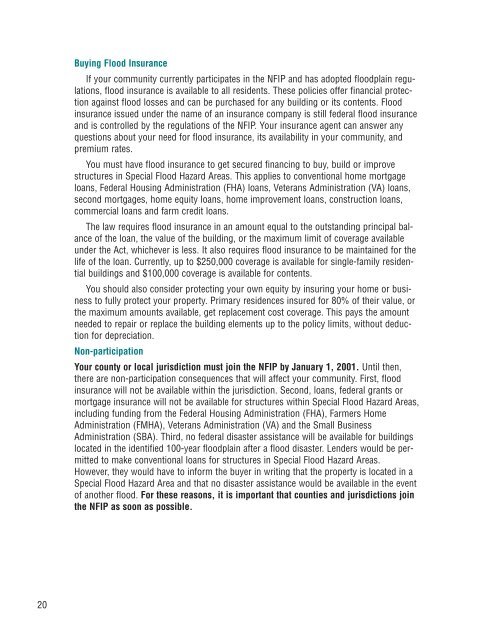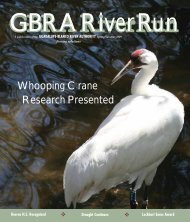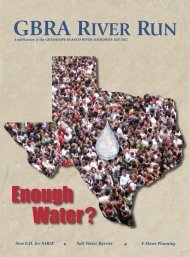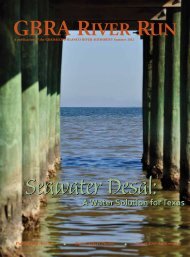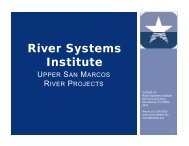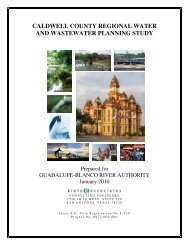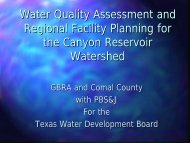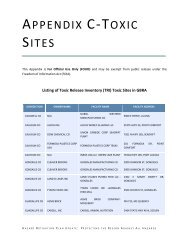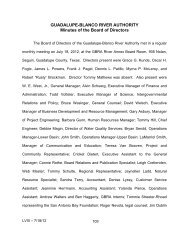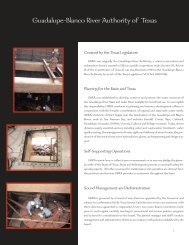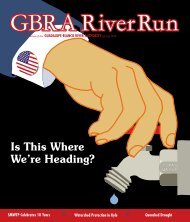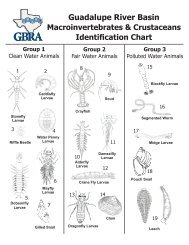Staying Safe Flood Guide - Guadalupe-Blanco River Authority
Staying Safe Flood Guide - Guadalupe-Blanco River Authority
Staying Safe Flood Guide - Guadalupe-Blanco River Authority
Create successful ePaper yourself
Turn your PDF publications into a flip-book with our unique Google optimized e-Paper software.
Buying <strong>Flood</strong> Insurance<br />
If your community currently participates in the NFIP and has adopted floodplain regulations,<br />
flood insurance is available to all residents. These policies offer financial protection<br />
against flood losses and can be purchased for any building or its contents. <strong>Flood</strong><br />
insurance issued under the name of an insurance company is still federal flood insurance<br />
and is controlled by the regulations of the NFIP. Your insurance agent can answer any<br />
questions about your need for flood insurance, its availability in your community, and<br />
premium rates.<br />
You must have flood insurance to get secured financing to buy, build or improve<br />
structures in Special <strong>Flood</strong> Hazard Areas. This applies to conventional home mortgage<br />
loans, Federal Housing Administration (FHA) loans, Veterans Administration (VA) loans,<br />
second mortgages, home equity loans, home improvement loans, construction loans,<br />
commercial loans and farm credit loans.<br />
The law requires flood insurance in an amount equal to the outstanding principal balance<br />
of the loan, the value of the building, or the maximum limit of coverage available<br />
under the Act, whichever is less. It also requires flood insurance to be maintained for the<br />
life of the loan. Currently, up to $250,000 coverage is available for single-family residential<br />
buildings and $100,000 coverage is available for contents.<br />
You should also consider protecting your own equity by insuring your home or business<br />
to fully protect your property. Primary residences insured for 80% of their value, or<br />
the maximum amounts available, get replacement cost coverage. This pays the amount<br />
needed to repair or replace the building elements up to the policy limits, without deduction<br />
for depreciation.<br />
Non-participation<br />
Your county or local jurisdiction must join the NFIP by January 1, 2001. Until then,<br />
there are non-participation consequences that will affect your community. First, flood<br />
insurance will not be available within the jurisdiction. Second, loans, federal grants or<br />
mortgage insurance will not be available for structures within Special <strong>Flood</strong> Hazard Areas,<br />
including funding from the Federal Housing Administration (FHA), Farmers Home<br />
Administration (FMHA), Veterans Administration (VA) and the Small Business<br />
Administration (SBA). Third, no federal disaster assistance will be available for buildings<br />
located in the identified 100-year floodplain after a flood disaster. Lenders would be permitted<br />
to make conventional loans for structures in Special <strong>Flood</strong> Hazard Areas.<br />
However, they would have to inform the buyer in writing that the property is located in a<br />
Special <strong>Flood</strong> Hazard Area and that no disaster assistance would be available in the event<br />
of another flood. For these reasons, it is important that counties and jurisdictions join<br />
the NFIP as soon as possible.<br />
20


